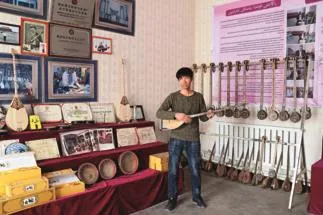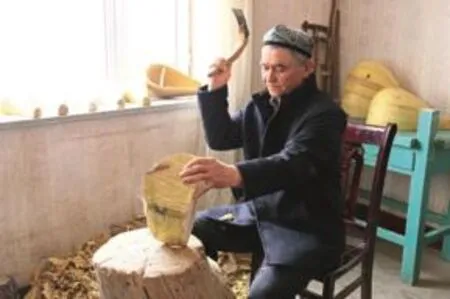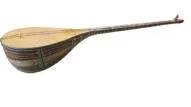MUSIC IN THE AIR
2019-04-26ByWangFengjuanLiChunxia
By Wang Fengjuan, Li Chunxia
A traditional Uygur musical instrument village
It didn't take long to travel the seven kilometers from Kashgar city center to the renowned “Folk Instrument Village.”
At the center of the village square is a three-meter-tall colored sculpture of Gijak ( fiddle). The main gate is a Uygur-style structure supported by 12 columns symbolizing the 12 Muqam (the 12-section classic music of the Uygurs). A variety of folk instruments are painted on the walls on both sides.
Towankukusak Village of Shufu County, Kashgar Prefecture, is wellknown for its tradition of producing folk musical instruments. For nearly 200 years, traditional Uygur musical instrument production has been the central industry of local villagers.
Inheritors of Intangible Cultural Heritage
We were lured by joyful melodies from the musical instrument workshop/showroom behind a white corridor. Mamudy Rahman was playing “Why Are the Flowers So Red?”, a Xinjiang folk classic. Some in the crowd began to hum along with the rhythm of the music.
“Making musical instruments has been my family business for four generations, and all six of my siblings are still involved in the business,”declared Mamudy as he proudly showed us pictures of his father and grandfather at work. Most of their products are sold in the village to wholesalers from Kashgar, and each family member earns an average of 20,000 yuan (US$2,973) yearly.

Tamboura.
In the same workshop is Mamudy's father, Abdullah Rahman,an inheritor of national intangible cultural heritage, folk musical instrument craftsmanship and Uygur musical instrument craftsmanship.He was chiseling on the pear-shaped soundbox of a Rawap (lute). He revealed that he learned to make and play the instrument from his father and grandfather when he was six years old. To master the skills,he suffered a lot of injuries and was left with many scars on his hands.After more than 60 years, the grayhaired man with calloused palms has become a real master of folk musical instruments.
In this workshop, you can see a display of the beautifully decorated instruments made by the Rahmans while enjoying their live performance. If you have the time,you can stay to observe the entire process of instrument making.The Rahmans spend several days polishing an instrument. “The soundbox is the most critical piece of this process,” noted Abdullah. “Its depth and thickness in fluence the tone quality.” He gently wiped away the scrapings and continued to work on the box with knives and chisels.
Abdullah thinks that innovation is as important for a craftsman as superb skills. The soundbox is normally covered with cattle or donkey hide.He tried replacing it with snake skin,which improved the sound quality and gave it more penetrating power.He shared this experience with the other craftsmen in the village. “The sound of music has blended with air in our village,” mused Abdullah. “I hope the skills and beautiful music will be passed on for many more generations in our village.”

Performance of a section of 12 Muqam, the 12-section classic music of the Uygurs.
Singular Instruments
Abdullah has many success stories. His bestknown instrument is a 4.7-meter-long Dutar(lute) with a 0.75-meter-widefingerboard.It took his team of 18—himself, his son and 16 apprentices—45 days to complete it.The instrument has been documented as a masterpiece in the Shanghai China Records,an honor which gives the villager great pride.However, deep in Abdullah's heart, he cherishes a piece of Rawap even more.
Young Abdullah had worked on the piece with his father for several years. It is still on display in the showroom to share its exquisite style and beautiful sound. At the end of last year, he received an offer of tens of thousands of dollars for it. But Abdullah held firm. “For me, this Rawap is a priceless treasure because it embodies the love and inheritance of the skills across several generations of my family,” he said. “I intend to pass it on to future generations to preserve the unique charm of folk instruments in my village.”

Mamudy Rahman plays Xinjiang folk music with Rawap.

Abdullah Rahman,a national intangible cultural heritage inheritor, chisels the soundbox of a Rawap.
Nugroho Fery Yudho from Indonesia was amazed by the unique instruments. He bought a meter-long Rawap as a souvenir. “Although I cannot play the instrument, I love its beautiful design and decoration,not to mention its unique sound,” he said with a big smile. “I'll take it home to remind me of this beautiful trip to Xinjiang.”
The folk instruments made in Kashgar Prefecture mainly include Dutar (lute), Rawap, Dap (drum) and Tamboura(lute). These instruments are unique with their exquisite craftsmanship, beautiful shapes and melodious tones. They can be used not only as musical instruments, but also as artistic decorations for homes. They are very popular with the Uygur people. Today, the instruments are sold not only in the domestic market, but also in the markets of Uzbekistan, Kazakhstan and Kyrgyzstan. Some small souvenir instruments are also sold in the European and U.S. markets.

Dutar.
Road to Prosperity
Folk instrument manufacturing in Kashgar Prefecture is based on the traditional techniques and rich natural resources provided by Chinese parasol, mulberry and walnut trees. With the assistance of modern technology, the traditional family business has been transformed into largescale industrial production of famous brands with distinct features.
In 1999, the local government invested 420,000 yuan (US$64,615) to build a folk instrument village as a base for the inheritors from seven villages to come together for specialized manufacturing of musical instrument and wooden handicrafts. In 2000, the village was designated as the “Folk Instrument Village in Xinjiang” by the State Council. At present, the village is having the capacity of producing 50 varieties of musical instruments in 27 major categories.
In June 2008, the folk instrument craftsmanship of Shufu County was listed as an item of national intangible cultural heritage. In August 2012, the Ministry of Culture published a list of national demonstration bases for the preservation of intangible cultural heritage items, including this village of Shufu County, the only one in all of Xinjiang Uygur Autonomous Region. Today, the village has become the bestknown production base of traditional musical instruments in the region.
Alongside the workshop, the village also hosts the Xinjiang Museum of Traditional Musical Instruments, consisting of an exhibition of lutefamily instruments, an exhibition of other folk instruments (mouth organs, flutes and pipes)and an interactive exhibition. The most popular of the exhibits are five over-sized instruments, a Dutar, Rawap, Sattar, Dap and Tamboura, which have been documented as masterpieces by Shanghai China Records, including Abdullah's Dutar.
“Our village used to be very poor,” Abdullah lamented. “Our road to prosperity began with large-scale production of musical instruments and wooden handicrafts—the craftsmen and businessmen merged their skills to create business opportunities in markets far from home.” Abdullah operates a store at the International Bazzar in Xinjiang's capital city Urumqi that sells traditional musical instruments made in his village.
Thanks to the development of the industry, the villagers have escaped poverty with an average annual income of 50,000 yuan (US$7,426) per household. “We're now living a comfortable life in a comfortable village in a comfortable county,”chuckled Abdullah.
“Shufu” and “comfortable” are homophones in Mandarin. The villagers have happily modified their village and county with the adjective.
